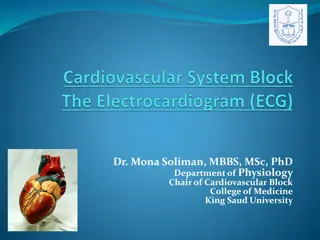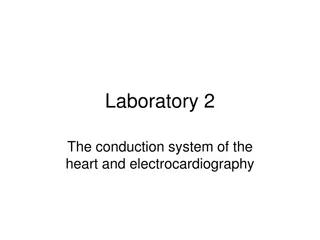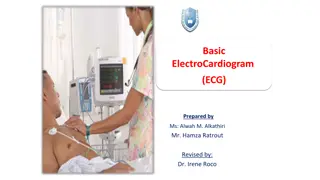
Understanding ECG: Electrocardiogram Basics for ER Trauma Cases
Explore the essentials of Electrocardiogram (ECG) for emergency trauma scenarios. Learn about normal ECG patterns, lead placements, and how to identify abnormal waves. Discover tips for creative ECG lead placement when necessary.
Download Presentation

Please find below an Image/Link to download the presentation.
The content on the website is provided AS IS for your information and personal use only. It may not be sold, licensed, or shared on other websites without obtaining consent from the author. If you encounter any issues during the download, it is possible that the publisher has removed the file from their server.
You are allowed to download the files provided on this website for personal or commercial use, subject to the condition that they are used lawfully. All files are the property of their respective owners.
The content on the website is provided AS IS for your information and personal use only. It may not be sold, licensed, or shared on other websites without obtaining consent from the author.
E N D
Presentation Transcript
ECG Review for ER Trauma Cases Ken Crump, AAS, AHT
ECG Review Electrocardiogram ECG? EKG? Same thing Displays a graph of the heart s electrical activity It tells you that there is electrical activity at the heart It does not tell you that the heart is responding to the electrical activity ECG does not tell you that the heart is beating Learn what normal looks like Learn where each lead attaches Stay creative Go to Making Anesthesia Easier blog post ECG and Me What do I need to know?
What Normal ECG Looks Like What to look for: P Wave QRS Complex T Wave What to notice: Missing waves Odd looking waves
ECG Lead I Standard Lead I The heart is between electrodes RA and LA
ECG Lead II The standard Lead II The heart is between electrodes RA and LL The most common diagnostic lead in vet med is Lead II
ECG Lead III The standard Lead III The heart is between electrodes LA and LL
ECG Lead Placement Normal Lead Placement
We are not cardiologists We look for two things: Normal waves Abnormal waves. Normal lead placement is nice, but not always possible depending on the species or the procedure. Sometimes we must get creative with lead placement.
Creative ECG Lead Placement Sometimes it is not possible to place electrodes in their proper position. Most ECG monitors default to display Lead II (RA / LL) The words arm and leg are meaningless They indicate the relative lead placement with reference to the heart The ECG monitor only displays the heart s electrical activity detected between two electrodes It doesn t matter where you place those two leads, as long as the heart is between them. The third electrode must be in contact with the body, but it doesn t matter where. Here are key points to remember when you need to be creative with your ECG Lead placement:
Creative ECG Lead Placement Where would you place ECG electrodes on this cat for a Lead II (RA / LL) ECG display? Note: Avoid the area around the cat s right foreleg because it will be manipulated during surgery producing unreadable motion artifact on your ECG display
Creative ECG Lead Placement There are a number of solutions to this puzzle, and they will all work so long as All three electrodes are in contact with the body The heart is positioned between two of the electrodes The ECG monitor displays the correct lead (I, II, or III) So get creative!
Your thoughts? Where would you place ECG electrodes on this cat for a Lead II (RA / LL) ECG display?
Creative ECG Lead Placement One possible solution Place the LL electrode on the cat s left leg Clip the RA electrode to the LA electrode Put the RA/LA electrodes (clipped together) in the cat s mouth
We are not cardiologists In summary we look for two things: Normal waves Missing or Abnormal waves. Sometimes we must be creative with lead placement.






















